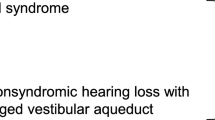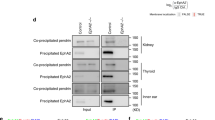Abstract
Pendred syndrome (PS) and non-syndromic enlarged vestibular aqueduct (EVA) are two recessive disorders characterized by the association of sensorineural hearing loss (SNHL) with inner ear malformations that range from isolated EVA to Mondini Dysplasia, a complex malformation that includes a cochlear dysplasia and EVA. Mutations in the SLC26A4 gene, coding for the protein pendrin, have been implicated in the pathophysiology of both disorders. In order to determine whether SLC26A4 genotypes can be correlated to the complexity and severity of the phenotypes, we ascertained 1,506 deaf patients. Inner ear abnormalities were present in 474 patients (32%). Mutation screening of SLC26A4 detected two mutations in 16% of patients, one mutation in 19% of patients and zero mutation in 65% of patients. When the distribution of SLC26A4 genotypes was compared across phenotypes, a statistically significant difference was found between PS patients and non-syndromic EVA–Mondini patients (P = 0.005), as well as between EVA patients and Mondini patients (P = 0.0003). There was a correlation between phenotypic complexity of inner ear malformations and genetic heterogeneity—PS patients have the most severe phenotype and the most homogeneous etiology while EVA patients have the least severe phenotype and the most heterogeneous etiology. For all patients, variability in the degree of hearing loss is seen across genotypes implicating other genetic and/or environmental factors in the pathogenesis of the PS–Mondini–EVA disease spectrum.




Similar content being viewed by others
References
Abe S, Usami S, Hoover DM, Cohn E, Shinkawa H, Kimberling WJ (1999) Fluctuating sensorineural hearing loss associated with enlarged vestibular aqueduct maps to 7q31, the region containing the Pendred gene. Am J Med Genet 82:322–328
Albert S, Blons H, Jonard L, Feldmann D, Chauvin P, Loundon N, Sergent-Allaoui A, Houang M, Joannard A, Schmerber S, Delobel B, Leman J, Journel H, Catros H, Dollfus H, Eliot MM, David A, Calais C, Drouin-Garraud V, Obstoy MF, Tran Ba Huy P, Lacombe D, Duriez F, Francannet C, Bitoun P, Petit C, Garabedian EN, Couderc R, Marlin S, Denoyelle F (2006) SLC26A4 gene is frequently involved in nonsyndromic hearing impairment with enlarged vestibular aqueduct in Caucasian populations. Eur J Hum Genet 14:773–779
Azaiez H, Smith R (2007) Temporal bone imaging in GJB2 Deafness. Laryngoscope 117(6):1127
Ballana E, Ventayol M, Rabionet R, Gasparini P, Estivill X (2007) Connexins and deafness Homepage. World wide web URL: http://www.davinci.crg.es/deafness/
Campbell C, Cucci RA, Prasad S, Green GE, Edeal JB, Galer CE, Karniski LP, Sheffield VC, Smith RJ (2001) Pendred syndrome, DFNB4, and PDS/SLC26A4 identification of eight novel mutations and possible genotype–phenotype correlations. Hum Mutat 17:403–411
Coyle B, Reardon W, Herbrick JA, Tsui LC, Gausden E, Lee J, Coffey R, Grueters A, Grossman A, Phelps PD, Luxon L, Kendall-Taylor P, Scherer SW, Trembath RC (1998) Molecular analysis of the PDS gene in Pendred syndrome. Hum Mol Genet 7:1105–1112
Cremers CW, Admiraal RJ, Huygen PL, Bolder C, Everett LA, Joosten FB, Green ED, van Camp G, Otten BJ (1998) Progressive hearing loss, hypoplasia of the cochlea and widened vestibular aqueducts are very common features in Pendred’s syndrome. Int J Pediatr Otorhinolaryngol 45:113–123
del Castillo FJ, Rodriguez-Ballesteros M, Alvarez A, Hutchin T, Leonardi E, de Oliveira CA, Azaiez H, Brownstein Z, Avenarius MR, Marlin S, Pandya A, Shahin H, Siemering KR, Weil D, Wuyts W, Aguirre LA, Martin Y, Moreno-Pelayo MA, Villamar M, Avraham KB, Dahl HH, Kanaan M, Nance WE, Petit C, Smith RJ, Van Camp G, Sartorato EL, Murgia A, Moreno F, del Castillo I (2005) A novel deletion involving the connexin-30 gene, del(GJB6-d13s1854), found in trans with mutations in the GJB2 gene (connexin-26) in subjects with DFNB1 non-syndromic hearing impairment. J Med Genet 42:588–594
del Castillo I, Villamar M, Moreno-Pelayo MA, del Castillo FJ, Alvarez A, Telleria D, Menendez I, Moreno F (2002) A deletion involving the connexin 30 gene in nonsyndromic hearing impairment. N Engl J Med 346:243–249
Denoyelle F, Marlin S, Weil D, Moatti L, Chauvin P, Garabedian EN, Petit C (1999) Clinical features of the prevalent form of childhood deafness, DFNB1, due to a connexin-26 gene defect: implications for genetic counselling. Lancet 353:1298–1303
Everett LA, Glaser B, Beck JC, Idol JR, Buchs A, Heyman M, Adawi F, Hazani E, Nassir E, Baxevanis AD, Sheffield VC, Green ED (1997) Pendred syndrome is caused by mutations in a putative sulphate transporter gene (PDS). Nat Genet 17:411–422
Everett LA, Morsli H, Wu DK, Green ED (1999) Expression pattern of the mouse ortholog of the Pendred’s syndrome gene (Pds) suggests a key role for pendrin in the inner ear. Proc Natl Acad Sci USA 96:9727–9732
Fraser GR (1965) Association of congenital deafness with goitre (Pendred’s syndrome) a study of 207 Families. Ann Hum Genet 28:201–249
Hulander M, Kiernan AE, Blomqvist SR, Carlsson P, Samuelsson EJ, Johansson BR, Steel KP, Enerback S (2003) Lack of pendrin expression leads to deafness and expansion of the endolymphatic compartment in inner ears of Foxi1 null mutant mice. Development 130:2013–2025
Jackler RK, De La Cruz A (1989) The large vestibular aqueduct syndrome. Laryngoscope 99:1238–1242; discussion 1242–1243
Kimberling WJ (2005) Estimation of the frequency of occult mutations for an autosomal recessive disease in the presence of genetic heterogeneity: application to genetic hearing loss disorders. Hum Mutat 26:462–470
Lopez-Bigas N, Melchionda S, de Cid R, Grifa A, Zelante L, Govea N, Arbones ML, Gasparini P, Estivill X (2002) Erratum: identification of five new mutations of PDS/SLC26A4 in Mediterranean families with hearing impairment. Hum Mutat 20:77–78
Park HJ, Shaukat S, Liu XZ, Hahn SH, Naz S, Ghosh M, Kim HN, Moon SK, Abe S, Tukamoto K, Riazuddin S, Kabra M, Erdenetungalag R, Radnaabazar J, Khan S, Pandya A, Usami SI, Nance WE, Wilcox ER, Riazuddin S, Griffith AJ (2003) Origins and frequencies of SLC26A4 (PDS) mutations in east and south Asians: global implications for the epidemiology of deafness. J Med Genet 40:242–248
Prasad S, Kolln KA, Cucci RA, Trembath RC, Van Camp G, Smith RJ (2004) Pendred syndrome and DFNB4-mutation screening of SLC26A4 by denaturing high-performance liquid chromatography and the identification of eleven novel mutations. Am J Med Genet A 124:1–9
Preciado MC, de la Guardia Brin JF (1986) Otitis media with effusion. Rev Med Panama 11:94–102
Propst EJ, Blaser S, Stockley TL, Harrison RV, Gordon KA, Papsin BC (2006) Temporal bone imaging in GJB2 deafness. Laryngoscope 116:2178–2186
Pryor SP, Madeo AC, Reynolds JC, Sarlis NJ, Arnos KS, Nance WE, Yang Y, Zalewski CK, Brewer CC, Butman JA, Griffith AJ (2005) SLC26A4/PDS genotype–phenotype correlation in hearing loss with enlargement of the vestibular aqueduct (EVA): evidence that Pendred syndrome and non-syndromic EVA are distinct clinical and genetic entities. J Med Genet 42:159–165
Reardon W, Coffey R, Phelps PD, Luxon LM, Stephens D, Kendall-Taylor P, Britton KE, Grossman A, Trembath R (1997) Pendred syndrome—100 years of underascertainment? QJM 90:443–447
Reardon W, OMahoney CF, Trembath R, Jan H, Phelps PD (2000) Enlarged vestibular aqueduct: a radiological marker of pendred syndrome, and mutation of the PDS gene. QJM 93:99–104
Scott DA, Karniski LP (2000) Human pendrin expressed in Xenopus laevis oocytes mediates chloride/formate exchange. Am J Physiol Cell Physiol 278:C207–C211
Scott DA, Wang R, Kreman TM, Sheffield VC, Karniski LP (1999) The Pendred syndrome gene encodes a chloride–iodide transport protein. Nat Genet 21:440–443
Scott DA, Wang R, Kreman TM, Andrews M, McDonald JM, Bishop JR, Smith RJ, Karniski LP, Sheffield VC (2000) Functional differences of the PDS gene product are associated with phenotypic variation in patients with Pendred syndrome and non-syndromic hearing loss (DFNB4). Hum Mol Genet 9:1709–1715
Sheykholeslami K, Schmerber S, Habiby Kermany M, Kaga K (2004) Vestibular-evoked myogenic potentials in three patients with large vestibular aqueduct. Hear Res 190:161–168
Smith RJ, Bale JF Jr, White KR (2005) Sensorineural hearing loss in children. Lancet 365:879–890
Tsukamoto K, Suzuki H, Harada D, Namba A, Abe S, Usami S (2003) Distribution and frequencies of PDS (SLC26A4) mutations in Pendred syndrome and nonsyndromic hearing loss associated with enlarged vestibular aqueduct: a unique spectrum of mutations in Japanese. Eur J Hum Genet 11:916–922
Valvassori GE, Clemis JD (1978) The large vestibular aqueduct syndrome. Laryngoscope 88:723–728
Van Hauwe P, Everett LA, Coucke P, Scott DA, Kraft ML, Ris-Stalpers C, Bolder C, Otten B, de Vijlder JJ, Dietrich NL, Ramesh A, Srisailapathy SC, Parving A, Cremers CW, Willems PJ, Smith RJ, Green ED, Van Camp G (1998) Two frequent missense mutations in Pendred syndrome. Hum Mol Genet 7:1099–1104
Yaeger D, McCallum J, Lewis K, Soslow L, Shah U, Potsic W, Stolle C, Krantz ID (2006) Outcomes of clinical examination and genetic testing of 500 individuals with hearing loss evaluated through a genetics of hearing loss clinic. Am J Med Genet A 140:827–836
Yang T, Vidarsson H, Rodrigo-Blomqvist S, Rosengren SS, Enerbäck S, Smith RJH (2007) Transcriptional control of SLC26A4 is involved in Pendred syndrome and non-syndromic enlargement of vestibular aqueduct (DFNB4). Am J Hum Genet 80(6):1055–1063
Acknowledgments
We thank the study patients and families for their participation in this study, which was supported in part by a grant from the NIDCD (R01-DC02842) to RJHS.
Author information
Authors and Affiliations
Corresponding author
Rights and permissions
About this article
Cite this article
Azaiez, H., Yang, T., Prasad, S. et al. Genotype–phenotype correlations for SLC26A4-related deafness. Hum Genet 122, 451–457 (2007). https://doi.org/10.1007/s00439-007-0415-2
Received:
Accepted:
Published:
Issue Date:
DOI: https://doi.org/10.1007/s00439-007-0415-2




